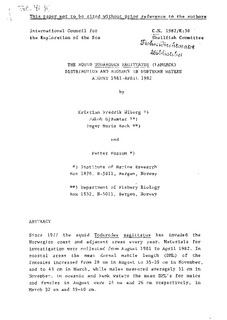| dc.description.abstract | Since 1977 the squid Todarodes sagittatus has invaded the Norwegian coast and adj acent areas every year. Materials for investigation were collected from August 1981 to April 1982. In coastal areas the mean dorsal mantle length (DML) of the femea1es increased from 28 cm in August to 35-39 cm in November, and to 43 cm in March, while males measured averagely 31 cm in November. In oceanic and bank waters the mean DML's for males and females in August were 24 cm and 26 cm respectively, in March 32 cm and 39-40 cm. Liver weight constituted 3-23% of total weight, in oceanic waters .with mean of about 7% in August and 11 % in March, in coastal areas 6-9% in August-November. The most important food items were fish (redfish, blue whiting, pearlside), cephalopods, euphausiids and amphipods. Males were usually scarce, 0-8.6% of the total number in fjord areas, 0-23% in open waters, but in March 1982 samples from the Viking bank had 80.8% males. In fjord areas nearly all males were immature in November, single larger animals maturing. In March most males in open waters were maturing or mature. Of the females, a few were in stage 4 in November, the majority immature. In March most females in open waters were in stage 2, a few in stage 3 and 4. Primary growth rings (GR) in the statoliths were counted and related to DML, and a functional GM-regression was fitted. In squid from the Hebrides-Faroe area in March-April 1981 the result was: DML=0.121GR + 1.850, r²=0.686, n=38. In squid from the Norwegian Sea and the coast of Norway August-November 1981: DML:=0.213GR - 31.020, r²=0,185, n=416. In the latter case the regression is significant (F=94.1, p<<0.01), but only 18% of the total variance is explained by linear regression. Most of the squid enters the area studied at an age of about 200 days. Local differences in available food may induce great variations in growth. Hatching periods indicated are: OctoberNovember, December-January, and March-May. During.August-November 1981, 3500 squid were tagged with anchor tags at 32 localities. Until June 10 1982, 26 tags have been recovered after maximum 66 days at or near the tagging locality. One squid was recovered after 154 days, 145 n. miles from the tagging site. In 1981 the Norwegian fishery yielded about 9000 m. tons of squid. | en_US |
